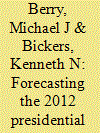| Srl | Item |
| 1 |
ID:
117586


|
|
|
|
|
| Publication |
2012.
|
| Summary/Abstract |
Engaging students in the design, administration, and postelection analysis of an exit poll can be an excellent experiential learning activity. Lelieveldt and Rossen (2009) argue that exit polls are a "perfect teaching tool" because they provide students with a cooperative (rather than competitive) learning experience; help students better connect theory, methodology, and course substance; and allow students to move outside of the classroom by branching out into the community. As professors at the University of Colorado, Denver (UCD), we have organized student exit polling during the 2008 and 2010 elections in the Denver area for research methods and elections classes. Although we have found these exit polls to be rewarding experiences for instructors and students alike, the reality is that conducting an exit poll with a group of polling neophytes, in the confines of a single semester, can be challenging. In this article, we discuss strategies and issues for instructors to consider when using an exit poll as an experiential learning exercise.
|
|
|
|
|
|
|
|
|
|
|
|
|
|
|
|
| 2 |
ID:
116466


|
|
|
|
|
| Publication |
2012.
|
| Summary/Abstract |
Nearly all forecast models of US presidential elections provide estimates of the national two-party vote (Campbell 2008). Each of the nine forecasts published in the 2008 forecasting issue of PS: Political Science and Politics made national popular vote total predictions for the major party candidates, while only one provided an expected result in the Electoral College (Klarner 2008). These national vote models are assumed to be reliable forecasts of who is likely to win the general election. In most cases, this assumption is reasonable. It becomes problematic, however, at precisely the point that forecasts are most interesting: when elections are close. In tight elections, national forecasts can and have produced a "winner" different from the actual winner. Consider the forecasts and ultimate outcome of the 2000 election. Each of the 2000 presidential election forecasts predicted vice president Al Gore to win a majority of the two-party popular vote, which he did, but none correctly predicted governor George W. Bush to assume the presidency (Campbell 2001). Never in US history have White House residents been determined through a national popular vote. Presidential elections are decided through contests in the states and the District of Columbia. The forecast model we developed explicitly models the presidential contest based on factors inherent to these 51 jurisdictions. This modeling approach allows us to make a projection of the Electoral College result, which popular vote estimates cannot.
|
|
|
|
|
|
|
|
|
|
|
|
|
|
|
|